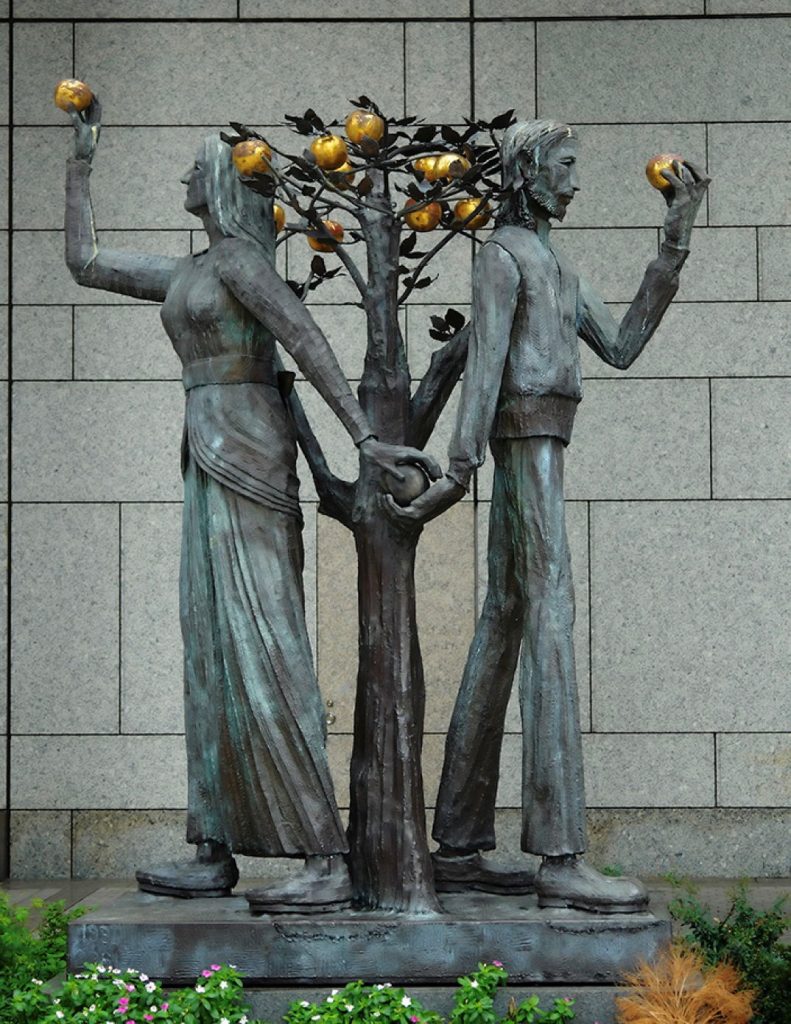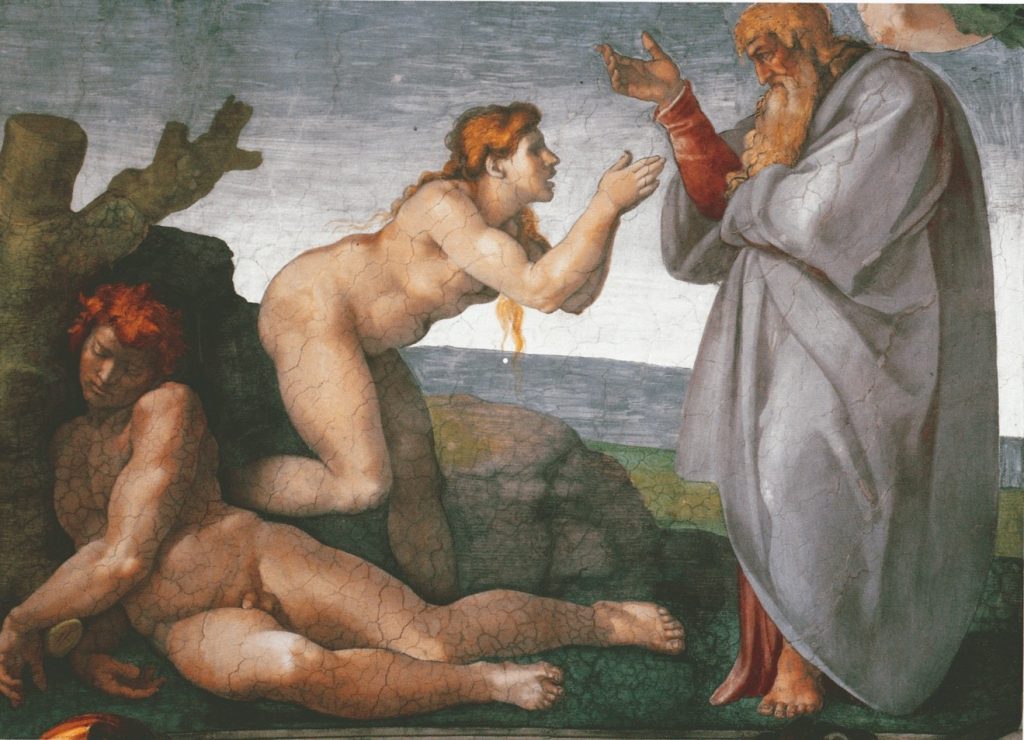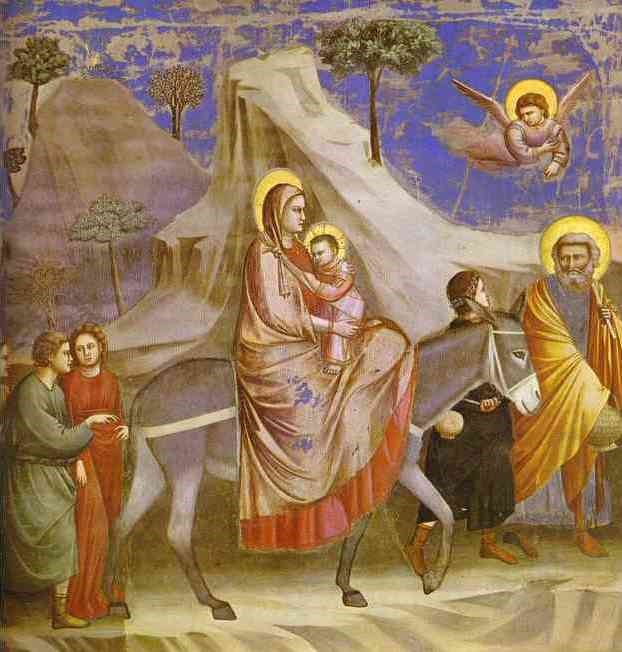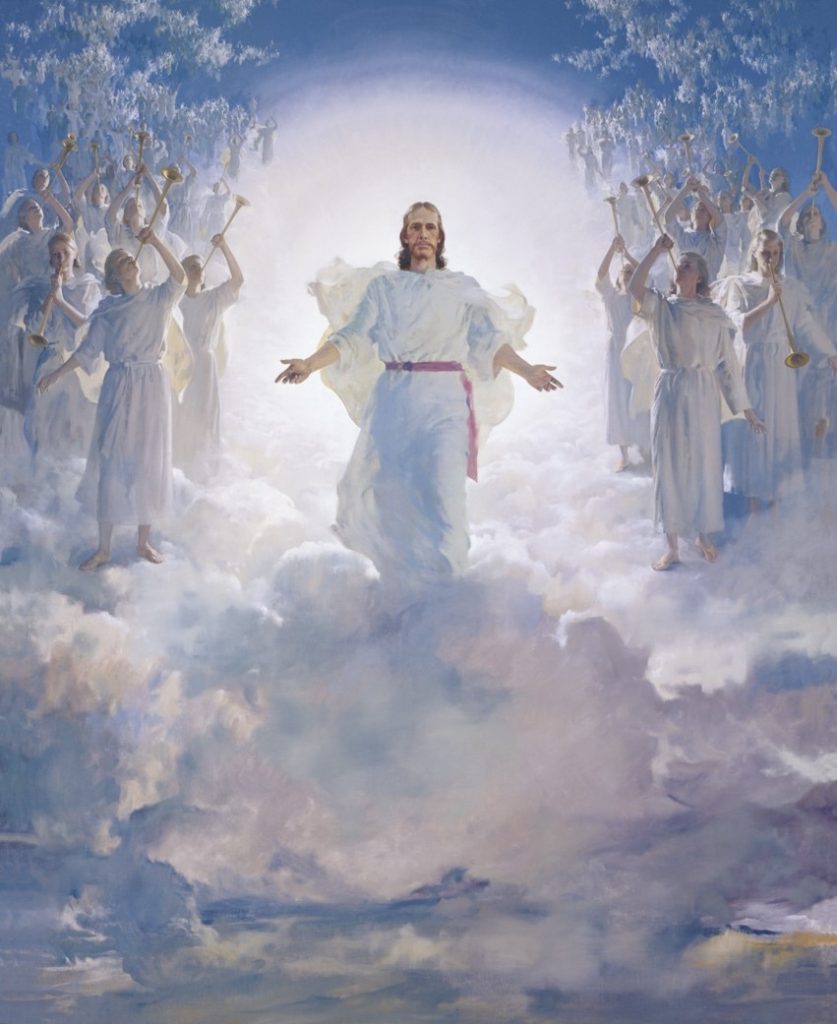
Figure 1. Adam and Eve. Tokyo, Japan[1]
The Fall and the Redemption in Traditional Christmas Carols
Though the event is rarely mentioned in modern Christmas celebrations, the traditional carols of earlier centuries often give as much attention to the Fall of Adam as they do to the birth and redemption of Christ. For example, after describing the creation of Adam and Eve, the English carol “This is the truth sent from above”[2] continues:
3. Then after that ’twas God’s own choice
To place them both in paradise
There to remain from evil free
Except they ate of such a tree.
4. But they did eat, which was a sin,
And thus their ruin did begin—
Ruined themselves, both you and me,
And all of our posterity.
5. Thus we were heirs to endless woes
Till God the Lord did interpose
And so a promise soon did run:
That he’d redeem us by his Son.Though, of course, Latter-day Saints have a much more positive view of the Fall and reject the traditional conception of “original sin,” the message of such carols recalls the gratitude for redemption through Christ shared by all Christians.
Figure 2. a. The Bond of Adam, after a church mural in Voronet, Moldavia, 1547[3]; b. Jerry Harston, 1943–: The Foolish Man and the Creditor, 1978[4]
Satan’s Hold on Adam by a Bond Is Broken by Christ
The first line of a fifteenth-century Christmas carol reads: “Adam lay ybounden / Bounden in a bond.”[5] The imagery of a “bond” comes as part of a long Christian tradition of stories about a series of unsuccessful attempts of Satan to deceive Adam and Eve, who become increasingly immune to his wiles through the knowledge and protective power provided by angelic teachings, covenants, and ordinances. One particular episode, the story of the cheirograph [i.e., contract, from Greek cheiro (hand) + graph (writing)] is illustrated at left above.
The story of the Cheirograph begins when the Devil claims ownership of the earth and accuses Adam of trespassing. In the image, part of the unique iconographical programme of four churches in North Moldavia, the robed Adam kneels before the naked Satan and “dutifully signs a bond of indebtedness that deeds over to [the ‘Lord of the Earth’ himself and] all his offspring.”[6] Satan’s plan to trap Adam through his legal machinations fails because, as Adam knows, God not Satan is the true “Lord of the earth.”[7]
A related sense of cheirograph is found in Colossians 2:14, where the Greek term should be translated “‘bond’ or ‘bill of indebtedness’ but not ‘contract.’ The text does not mention Satan or Adam and seems to say that at the Crucifixion, Christ erased the bill of indebtedness that humans had incurred by sinning and nailed it to the Cross.”[8] In other words, just as in Roman times cancelled bills were nailed up for display to publicly announce that the charges had been paid, so Christ was nailed to the cross to make it known to all that He had satisfied humankind’s debt of sin.
According to the ancient symbolism, the handwritten bond of justice was annulled by the “writing” of the nails in the pierced hands of the Savior — Christ’s cheirograph of mercy, as it is often called.[9] This symbolism is consistent with a late Ethiopian text of the attempt of the penitent thief who was crucified with Christ to enter Paradise. He succeeds at last only when he shows the Cherubim guarding the gates “the writing which was in his hand, [that] was written in the blood … of our Lord Jesus Christ.”[10] Likewise, the Mandaean Ginza states that the ascending one will be greeted by “the one who holds the nails of glory and the signs in the hands, and the key of the kushta of both arms,”[11] signaling a concluding embrace.
In contrast to stories that emphasize the role of Satan as a deceiver and tempter, a Jewish midrash employs him not as “a figure of complete evil” but rather as a means to represent “the principle of justice.”[12] At right is an illustration from Elder Boyd K. Packer’s parable, The Mediator, which shares similar themes.[13] The Mediator is concerned, not with a tale about Satan’s fraud in claiming ownership of the earth, but rather with the dilemma of trying to reconcile the strict demands of justice with mankind’s need for mercy. Though the subject of the story represents, like Adam, an “Everyman,” his antagonist is not the Devil but rather an unyielding creditor who demands that the terms of the contract for repayment of a loan be fully satisfied, despite the entreaties of his client for mercy. The Mediator, of course, represents Jesus Christ, who “atoneth for the sins of the world, to bring about the plan of mercy, to appease the demands of justice, that God might be a perfect, just God, and a merciful God also.”[14]
Figure 3. Michelangelo Buonarotti, 1475-1564: The Creation of Eve, 1510[15]
The Creation of Eve and the Role of Mary in the Birth of the Christian Church
Moses 3:21–22 describes this scene: “And I, the Lord God, caused a deep sleep to fall upon Adam. … And the rib which I, the Lord God, had taken from man, made I a woman.”[16] Giorgio Vasari contrasts the poses of Adam and Eve: “One [is] almost dead from being imprisoned by sleep, while the other comes alive completely reawakened by the benediction of God. The brush of this most ingenious artisan[, Michelangelo,] reveals the true difference between sleep and awakening, as well as how stable and firm His Divine Majesty may appear when speaking in human terms.”[17]
Upon closer examination, it becomes apparent that the symbolism of the painting extends beyond the Creation and looks forward to the crucifixion of Jesus Christ and the birth of the Church that would carry out the divine commission to carry the Gospel to all the world.[18] In his analysis of the painting, Gary A. Anderson notes some details that are “highly unusual”:
Adam lies slumped around a dead tree, an odd sight for a luxuriant garden where death was, as of yet, unknown. The only way to understand this tired figure is to see him as a prefigurement of Christ, the “second Adam,” who was destined to hang on a barren piece of wood. “The sleep of [Adam],” the fourth-century theologian St. Augustine observed, “clearly stood for the death of Christ.”[19] … If this is how we are to read this image of Adam, perhaps a similar interpretation holds for Eve.
To get our bearings on this we must bear in mind two facts. First, Mary as the “second Eve” is she who gives birth to Christ. Second, Mary as the “symbol of the church” is she who emerges from the rib of Christ on the Cross[, symbolized by the blood and water that issued from His side]. In this central panel of the Sistine ceiling, we see both the first and second Eve emerging from the ribs of Adam. …
Further support for this comes from the history of the chapel itself. It was built on the model of Solomon’s Temple and was dedicated on August 15, 1483, the feast day of the Assumption and Coronation of the Virgin Mary in Heaven. A favored image of Mary in Christian devotional practice was Mary as the ark or tabernacle of God. Like the Ark of the Covenant in the Old Testament, the throne upon which God almighty took his seat, Mary was the seat in which God took human form. Like the Temple itself, she housed the verum corpus or the “true body” of God.”[20] Significantly, this image is the center point of the entire chapel ceiling.
Thus the image illustrates the roles of Eve and Mary as central to the plan of salvation.
Figure 4. German School in Cologne, after Martin Scöngaeur: Flight into Egypt, 16th century CE[21]
The Cherry Tree Carol
Another traditional carol, called “The Cherry Tree,”[22] describes an incident that is supposed to have occurred during Joseph and Mary’s journey to Bethlehem — or alternatively as shown in this particular depiction, during the flight to Egypt after Jesus’ birth. The illustration shows a group of angels above the couple, bending down the trunk of a fruit tree and plucking its fruit:
3. Joseph and Mary walked through an orchard good,
Where was cherries and berries, so red as any blood. …5. O then bespoke Mary, so meek and so mild:
“Pluck me a cherry, Joseph; they run so in my mind.6. O then bespoke Joseph, with words most reviled:
“Let him pluck thee a cherry that brought thee with child.”7. O then bespoke Jesus, all in his mother’s womb:
“Bow down, then, thou tallest tree, for my mother to have some!”The lesson of this fanciful story is clear: Joseph (and any contemporary hearers of this carol) are to quell any doubts they may have about the divine patrimony of Jesus. Indeed, God the Father, the very One “that brought [Mary] with child” by the Holy Ghost, is the One who created the tree to nourish Mary. And, in its obedience to the request of the not-yet-born Jesus to “bow down,” the cherry tree becomes nature’s witness to the innocence and purity of the holy Child’s mother.
Figure 5.Giotto di Bondone, ca. 1266–1337: Flight into Egypt, 1304–1306 CE. Scroveghi (Arena) Chapel, Padua, Italy[23]
The image of the orchard offering its fruit to Mary becomes even more fitting in light of evidence that the branch from which she plucks belongs to no ordinary tree. Symbolically, it is the Tree of Life,[24] with the original palm tree having been changed to a cherry tree.[25] Note the position of Mary’s tree represented as growing on the slopes of the holy mountain in this depiction by Giotto. Thus, Mary, as the new and perfect “Eve,” is being represented as worthy to partake of the Tree of Life.
It is true that Adam and Eve’s departure from the Garden of Eden barred them and their posterity for a time from the Tree of Life. However, a rabbinic tradition has it that the last divine word that rang in the ears of Adam and Eve as they left the Garden of Eden was tashub, meaning “You shall return!”[26]
Figure 6. Harry Anderson, 1906–1996: The Second Coming, ca. 1969[27]
The Return of Jesus Christ
It is the testimony of scripture that as surely as Jesus came once as a babe in Bethlehem, He shall come again a second time to the earth.[28] Hence, just as Latter-day Saints at Easter time add the symbol of the empty tomb to that of the cross, so at Christmas time, we should not think it inappropriate to hang a painting of his coming in glory next to the manger scene. When we carol, let us sing not only Silent Night, but also The Day Dawn is Breaking; to O Come All Ye Faithful let us add Come O Thou King of Kings; with I Wonder as I Wander, we should sing I Wonder When He Comes Again.
References
Anderson, Gary A. The Genesis of Perfection: Adam and Eve in Jewish and Christian Imagination. Louisville, KY: Westminster John Knox Press, 2001.
Augustine. ca. 410. "The City of God." In Nicene and Post-Nicene Fathers, First Series, edited by Philip Schaff. 14 vols. Vol. 2, 1-511. New York City, NY: The Christian Literature Company, 1887. Reprint, Peabody, MA: Hendrickson Publishers, 1994.
Bradshaw, Jeffrey M. In God’s Image and Likeness: Ancient and Modern Perspectives on the Book of Moses. Salt Lake City, UT: Eborn Publishing, 2010.
———. Creation, Fall, and the Story of Adam and Eve. 2014 Updated ed. In God’s Image and Likeness 1. Salt Lake City, UT: Eborn Books, 2014. https://archive.org/details/140123IGIL12014ReadingS.
———. "What did Joseph Smith know about modern temple ordinances by 1836?”." In The Temple: Ancient and Restored. Proceedings of the 2014 Temple on Mount Zion Symposium, edited by Stephen D. Ricks and Donald W. Parry. Temple on Mount Zion 3, 1-144. Orem and Salt Lake City, UT: The Interpreter Foundation and Eborn Books, 2016. http://www.jeffreymbradshaw.net/templethemes/publications/01-Bradshaw-TMZ%203.pdf.
Carr, Sherwyn T. "The middle English nativity cherry tree: The dissemination of a popular motif." Modern Language Quarterly 36, no. 2 (1975): 133-47. http://mlq.dukejournals.org/cgi/pdf_extract/36/2/133. (accessed 19 December).
Cyril of Jerusalem. ca. 347. "Five Catechetical Lectures to the Newly Baptized on the Mysteries." In Nicene and Post-Nicene Fathers, Second Series, edited by Philip Schaff and Henry Wace. 14 vols. Vol. 7, 144-57. New York City, NY: The Christian Literature Company, 1894. Reprint, Peabody, MA: Hendrickson Publishers, 1994.
De Vecchi, Pierluigi, and Gianluigi Colalucci. Michelangelo: The Vatican Frescoes. Translated by David Stanton and Andrew Ellis. New York City, NY: Abbeville Press Publishers, 1996.
Elliott, J. K., ed. A Synopsis of the Apocryphal Nativity and Infancy Narratives. New Testament Tools and Studies 34, ed. Bruce M. Metzger and Bart D. Ehrman. Leiden, The Netherlands: Brill, 2006.
Hafen, Bruce C. Covenant Hearts: Marriage and the Joy of Human Love. Salt Lake City, UT: Deseret Book, 2005.
Henry, Paul. Les Églises de Moldavie du Nord, des Origines à la Fin du XVIe Siècle. 2 vols. Monuments de l’Art Byzantin 6. Paris, France: Ernest Leroux, 1930.
Isar, Nicoletta. "The dance of Adam: Reconstructing the Byzantine choros." Byzantino-Slavica: Revue Internationale des Études Byzantines 61 (2003): 179-204.
Keyte, Hugh, and Andrew Parrott. The New Oxford Book of Carols. Oxford, England: Oxford University Press, 1994.
Kierkegaard, Soren. Parables of Kierkegaard. Princeton, NJ: Princeton University Press, 1978.
LaCocque, André. The Trial of Innocence: Adam, Eve, and the Yahwist. Eugene, OR: Cascade Books, 2006.
Lidzbarski, Mark, ed. Ginza: Der Schatz oder das Grosse Buch der Mandäer. Quellen der Religionsgeschichte, der Reihenfolge des Erscheinens 13:4. Göttingen and Leipzig, Germany: Vandenhoeck & Ruprecht, J. C. Hinrichs’sche, 1925. https://ia802305.us.archive.org/7/items/MN41563ucmf_2/MN41563ucmf_2.pdf. (accessed September 7, 2019).
Madsen, Truman G. "The suffering servant." In The Redeemer: Reflections on the Life and Teachings of Jesus the Christ, 223-48. Salt Lake City, UT: Deseret Book, 2000.
Malan, Solomon Caesar, ed. The Book of Adam and Eve: Also Called The Conflict of Adam and Eve with Satan: A Book of the Early Eastern Church. Translated from the Ethiopic, with Notes from the Kufale, Talmud, Midrashim, and Other Eastern Works. London, England: Williams and Norgate, 1882. Reprint, San Diego, CA: The Book Tree, 2005.
Mika’el, Isaac, son of Bakhayla. ca. 1400. "Discourse concerning the mystery of the Godhead and the Trinity." In The Book of the Mysteries of the Heavens and the Earth and Other Works of Bakhayla Mika’el (Zosimas), edited by E. A. Wallis Budge, 126-39. Oxford, England: Oxford University Press, 1934. Reprint, Berwick, ME: Ibis Press, 2004.
Nibley, Hugh W. 1967. "Apocryphal writings and the teachings of the Dead Sea Scrolls." In Temple and Cosmos: Beyond This Ignorant Present, edited by Don E. Norton. The Collected Works of Hugh Nibley 12, 264-335. Salt Lake City: Deseret Book, 1992.
Packer, Boyd K. "The Mediator." Ensign 7, May 1977, 54-55.
———. The Mediator. Salt Lake City, UT: Deseret Book, 1978.
Robinson, Stephen E. Believing Christ. Salt Lake City, UT: Deseret Book, 1992.
Stone, Michael E. "The legend of the cheirograph of Adam." In Literature on Adam and Eve: Collected Essays, edited by Gary A. Anderson, Michael E. Stone and Johannes Tromp, 149-66. Leiden, Netherlands: Brill, 2000.
———. Adam’s Contract with Satan: The Legend of the Cheirograph of Adam. Bloomington, IN: Indiana University Press, 2002.
Endnotes
[1] Photo copyright by Stephen T. Whitlock. With permission.
[2] H. Keyte et al., New Oxford, 150, p. 519.
[3] From P. Henry, Moldavie, 2:246. Public Domain. For more explanation of this figure, see J. M. Bradshaw, God’s Image 1, pp. 332–333.
[4] With permission, thanks to the assistance of Pat Williams of Deseret Book. Published in B. K. Packer, Mediator 1978, p. 9. For more explanation of this figure, see J. M. Bradshaw, God’s Image 1, pp. 333–335.
[5] H. Keyte et al., New Oxford, 121, p. 426.
[6] G. A. Anderson, Perfection, p. 163.
[7] The illustration is from P. Henry, Moldavie, 2:246, republished in G. A. Anderson, Perfection, p. 163. See also M. E. Stone, Adam’s Contract, pp. 57-59.
[8] M. E. Stone, Legend, p. 153. See also J. Chrysostom, cited in ibid., p. 155.
[9] See I. Mika’el, son of Bakhayla, Godhead, p. 136; cf. S. C. Malan, Adam and Eve, 1:69, pp. 83-84. See also Cyril of Jerusalem, Five, 2:5, p. 148; B. C. Hafen, Covenant, pp. 75-84; S. E. Robinson, Believing, pp. 24-25; T. G. Madsen, Suffering, pp. 234, 240-241; Romans 8:17; 2 Corinthians 4:10; Galatians 2:20, 6:17; 1 Kings 18:28; Zechariah 13:6.
[10] I. Mika’el, son of Bakhayla, Godhead, p. 136. See also N. Isar, Dance of Adam, pp. 180–181. Cf. Isaiah 49:16; Zechariah 13:6; Cyril of Jerusalem, Five, 2:5, p. 148. See also J. M. Bradshaw, God’s Image 1, pp. 355, 359, 617–621.
[11] M. Lidzbarski, Ginza, GL 1:1, p. 429, cited in H. W. Nibley, Apocryphal, p. 300. For more on the ancient symbolism and the handclasp and the embrace, see J. M. Bradshaw, What Did Joseph Smith Know, pp. 15–27.
[12] See G. A. Anderson, Perfection, pp. 167–168.
[13] B. K. Packer, Mediator 1977.
[14] Alma 42:15.
[15] Public domain. https://en.wikipedia.org/wiki/File:Michelangelo,_Creation_of_Eve_00.jpg (accessed September 7, 2020).
[16] Moses 3:21-22.
[17] P. De Vecchi et al., Michelangelo, p. 151.
[18] See Matthew 28:19–20; Mark 16:15.
[19] See Augustine, City, 22:17, p. 496.
[20] G. A. Anderson, Perfection, pp. 5–8.
[21] See Art and Architecture, http://www.artandarchitecture.org.uk/images/gallery/3c4ca17d.html (accessed December 13, 2020). Copyright the Samuel Courtauld Trust, the Courtauld Gallery, London, England.
[22] H. Keyte et al., New Oxford, 128, p. 441–445.
[23] WikiArt, https://www.wikiart.org/en/giotto/flight-into-egypt (December 13, 2020). Public Domain.
[24] For a discussion on the symbolism of the Tree of Life, including connections with Mary, see J. M. Bradshaw, God’s Image, pp. 163-164. On the date palm as a representation of the Tree of Life, see ibid., pp. 165-167.
[25] The story is clearly derived from Pseudo-Matthew where we read:On the third day of their journey, whilst they were walking, the blessed Mary was tired by the excessive heat of the sun in the desert. On seeing a palm tree, she said to Joseph, “Let me rest here a little under the shade of this tree.’ Joseph therefore quickly led her to the palm, and helped her dismount from her beast. As the blessed Mary was sitting there, she looked up to the foliage of the palm and saw that it was full of fruit, and she said to Joseph, ‘I wish that it were possible to get some of the fruit of this palm.’ Joseph said to her, ‘Why do you say that when you can see how high the palm tree is’… Then the child Jesus, with a joyful countenance and resting on his mother’s lap, said to the palm: ‘O tree, bend your branches and refresh my mother with your fruit’” (J. K. Elliott, Synopsis, Pseudo-Matthew, 20, pp. 114).
Like the version of the account found in Qur’an 19:22, the event in the carol “has been transposed from the post-natal flight into Egypt to the pre-natal journey to Bethlehem, with Christ effecting the miracle from within his mother’s womb” (H. Keyte et al., New Oxford, p. 444). For the story of how the transformation from palm tree to cherry tree took place, see S. T. Carr, Cherry Tree. There are also borrowings from the Protoevangelion of James, where Joseph is depicted as having doubted the child’s paternity (J. K. Elliott, Synopsis, Protoevangelion of James, 13:1-14:1, pp. 43-44). “In the ballad [of the cherry tree] this jealousy is presented with a clever use of dramatic irony, since his waspish ‘Let him pluck thee a cherry that brought thee with child’ is followed by their immediate provision by the unborn Christ, who in theological terms [current at that time] is not to be differentiated from the Creator God who had indeed got Mary with child by the Holy Ghost” (H. Keyte et al., New Oxford, p. 445).
[26] A. LaCocque, Trial, p. 31.
[27] https://www.churchofjesuschrist.org/media/image/the-second-coming-a824e2d?lang=eng&collectionId=fc9c21562fde48cb906a9d775d463fb8 (December 13, 2020). Licensed for noncommercial use.
[28] If it is hard for moderns to believe in the literality of Jesus’ divine birth, it is even more difficult to take seriously the reality of His return, as the following parable from the great Danish Christian, Søren Kierkegaard, illustrates:“It happened that a fire broke out backstage in a theater. The clown came out to inform the public. They thought it was just a jest and applauded. He repeated his warning, they shouted even louder. So I think the world will come to an end amid general applause from all the wits, who believe that it is a joke” (S. Kierkegaard, Parables, p. 3).







